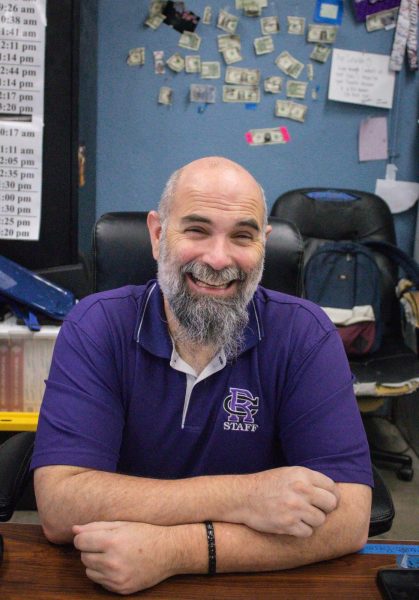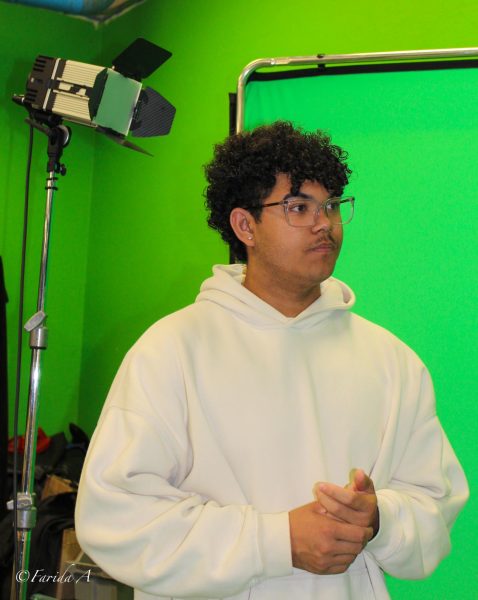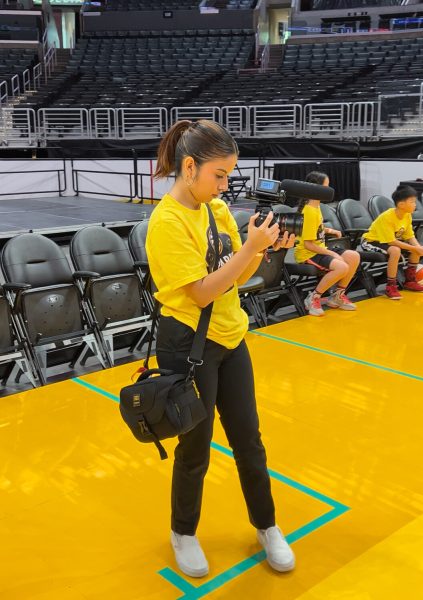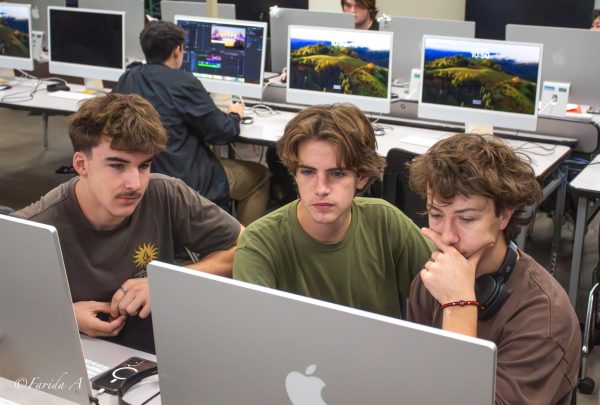Quiet on set, rolling in 3, 2, 1. Action!
The phrase is heard all year round. Students and staff always see groups of students filming and having a blast with creativity in RCHS’s Digital Film class.
Digital Film is a program at Rancho Cucamonga High School that creates student-produced televised bulletins that air three times weekly. The RCHS TV Bulletin airs in the morning during the 2nd period Tuesday through Thursday. The bulletin is also published on YouTube.
Leading the program

Mr. Matthew Cataldo, the Digital Film teacher, discussed how students in the program started making their films and his teaching history.
“Well, we start with Digital Film 1, where we learn how to create, edit, shoot, produce, direct, and make all of our films,” Cataldo said. “It’s been my life for the last 26 years from creating the Bulletin that we have today, from what was almost nothing when I got here.”
Cataldo has taught the Digital Film program at RCHS since 1999. The Digital Film program has two class types: Digital Film 1 and Advanced Digital Film. Digital Film 1 is a beginner class that teaches editing, shooting, producing, directing, script writing, using equipment, etc. Advanced Digital Film, also known as the bulletin class, is the class that produces the bulletin, and it is only offered during second period.
“Creating the advanced class, putting 400 plus kids into the industry, currently 100 plus kids in film school … means the world to me,” Cataldo said. “It’s right below family and God.”
Cataldo helped to highlight the importance of not only the Digital Film program, but also the significance of all the programs at RCHS. He said that each program on campus helps one another.
The Digital Film program is just one of the many programs offered on the RCHS campus. Cataldo said that all of the programs help contribute to the bulletin’s success.
“Without ASB and Student Achievement, we don’t have anybody coming up with ideas, putting on performances, and organizing events,” Cataldo said. “Without graphics, Digital Film, and a wood shop, we wouldn’t have the creative parts that design and make all the things that go into those productions possible. I think all together, we’re a cohesive group, and there isn’t one program that is more significant.”
Cataldo emphasized that regardless of how many students enjoy the Bulletin, there will always be some who dislike it. He explained that people who are negative about the Bulletin are typically not the ones involved with any programs, sports, clubs, or other activities at the school.
“We have created a different culture,” Cataldo smiles, “When it comes to what we did video-wise, we get contacted by schools around the area asking us how we do things, and what we do. They don’t have what we have, and some of them wish they could be here and be at our level, but it’s very hard. It’s dedication day in and day out. It’s a huge piece of us, our past graduates come back for decades to help us, motivate us, show us what’s going on in the world, and we’re just a giant family of almost three decades.”
Student insight
The Digital Film program isn’t just a classroom for students; it’s a home. The bulletin room has harbored many successful students who have taken their film skills to make a living while enjoying their careers. Cataldo and his program have offered students a home, a safe space, a room filled with laughter, and the widest variety of conversations. In the program, students learn about more than just film.

Miles DeCoudreaux a junior and third-year bulletin student discussed his experience in the program and provided a first-hand experience of being a part of the bulletin program as a student. He participated in the Renaissance Rally at RCHS in 2024. He said how this year he almost wasn’t going to be in the class and it made him very nervous since the bulletin is a safe haven for him and many students.
“It lets the students express themselves with video,” DeCoudreaux said. “I joined the official bulletin class last year, and that was the most fun I’ve had. It’s like no other class I’ve ever been in. It’s something I’d never want to replace. Just this year, I didn’t have a Bulletin in my schedule for the first two weeks. I was arguing with my parents and counselors to get me into this class because I did not want to leave. This class is so much fun, and it is like a second family. It’s fantastic. The atmosphere, it’s positive. Everyone wants to do stuff, and to be better.”
DeCoudreaux talked about previous graduating years, and how this program is run mostly by students. He highlighted how the program helps with collaboration and teamwork with your peers, and it’s enjoyable since you are making bonds, earning, and excelling.
“This class has impacted a lot of people from our class right now to previous classes,” DeCoudreaux said. “Man, this connects with you as a student. You’re bonding with the students here. This is run by students. So you’re basically on your own in this class. You and other students around you collaborate nonstop. That’s going to connect with you and the more you work, you get to know these people. You get to grow with them, you get to learn more with them, and you get to know them personally. It’s really nice.”
A former student and her success
Pamela (Pam) Tojín graduated from RCHS in 2023 and was a member of the RCHS TV Bulletin for three years. She shared about her time in the Digital Film program.

“The Digital Film program trains you,” said Tojín. “How to do every aspect that you would need to produce any type of video, both film, storytelling, video coverage of events, making interviews, how to use the cameras, the editing software to use, how to write the script, and how to direct in a way where you can get the video that you are looking for.”
Tojín is currently a sophomore at Chaffey College. She operates a small business filming and promoting business and events, hoping to turn it into a media company someday. She emphasized how the Digital Film program teaches and helps the students excel at making it possible for her to do what she does today.
“Digital Film, I just love it,” said Tojín. “It’s like the way I choose to express myself, especially during this class, you get to learn so many different ways to film. I just love, the story aspect of it, because for me, a video Digital Film means that I’m telling a story.”
Tojín went on to explain how she and many people love the program who have participated, and it lets people tell a story, their story.
“I told Cataldo this after I graduated, no class, no class has prepared me more for the real world than this class,” Tojín said. “That’s crazy because I did a lot of classes. But for me, it’s especially like going directly into the field. It’s how every little thing that’s taught in this class ends up being a real-life skill that I need. For example, the deadlines, and it’s even the little habits that he teaches to be on time, or to upload your footage right away, to preplan before you shoot small stuff. He got us into the habit of doing.”
Tojín explained that the program, and especially Cataldo’s way of teaching, gave her the skills she uses in her everyday life.
“It impacted me just because not only did I learn all these skills, but it gave me a network and support system because I got to interact with everyone in my class here,” Tojín said. “It’s just amazing seeing all the connections I made and what everyone else is doing. It’s not just me, It’s everyone in my class who ended up doing something different, and that’s the coolest part about it. That’s what I always loved about the class.”
Tojín said the program not only gave her skills she could apply outside of school, but she was allowed to work and interact with all her classmates, which shows how it is one big family. The students who have taken this class have had success in their careers whether or not they choose to pursue film.
“I feel it just really provided me a support system, a network, and overall, especially Cataldo,” Tojín said. “He has been so supportive even out of high school, which is crazy because a lot of teachers will be like, oh bye, sayonara! But Cataldo, you know, he’s there to give me advice and to help me outside of high school, in this industry that he’s experienced in.”
Continuing success
The Digital Film program at RCHS is truly a special place for students to explore their creativity and build lasting friendships. Under Cataldo’s guidance, this program has been a home for many, offering not just filmmaking skills but a supportive community that feels like family.
Students, both current and former, often share how the program has changed their lives. It’s about more than just making videos; it’s about telling stories that matter and connecting with others who share the same passion. Those moments spent collaborating in the bulletin room turn into memories and lifelong bonds.
As they grow and learn together, students gain important life skills that prepare them for whatever comes next, whether in film or other paths. The Digital Film program isn’t just a class; it’s a space where creativity flourishes and friendships grow. The program’s focus on collaboration and support continues to inspire new generations of filmmakers and leaders, ensuring that RCHS remains a place where creativity thrives for years to come.





